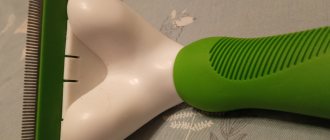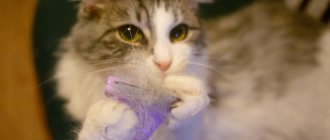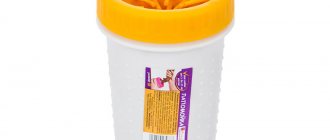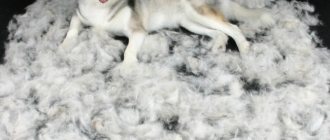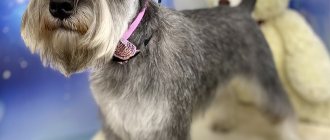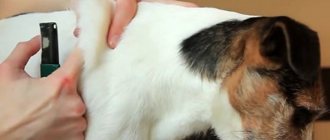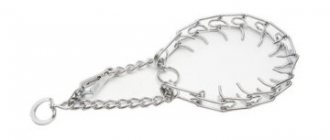Every pet needs care. Many owners are concerned about the nutrition and health of their four-legged friends, but ignore grooming procedures. Given the abundance of hair on some pets, brushing can be a lot of trouble. An indispensable assistant in home grooming is the furminator for dogs. Features of using the accessory and a review of leading brands are discussed in the article.
Furminator for dogs
Furminator for dogs - what is it and how does it work
The Furminator is an improved comb for removing undercoat on dogs, cats, rabbits, and horses. The tool was invented by American groomers Angie and David Porter. In 2000, they patented the FURminator deShedding trademark and launched production in China.
Now other companies are creating furminator combs. The FURminator brand name has evolved into the name of a tool for manually removing loose hair from pets.
Externally, the furminator resembles a razor, but instead of blades, a comb is attached to the handle. The teeth along their length are covered with excisions invisible to the eye, and are rounded at the tips. The distance between them is strictly adjusted so that the guard hair can pass freely.
When combing, the comb catches dead hair and lifts it to the surface without cutting or tugging. “Living” guard and integumentary hair slips between the teeth and remains intact.
Who is recommended for combing with a furminator?
As it becomes clear from the purpose of the tool, it is needed by animals with thick undercoat. The spine may not be thick or long - it doesn’t matter. The Furminator for dogs “works” only with the undercoat.
These dogs include long-haired shepherd dogs - German, Eastern European, Central Asian, Caucasian, South Russian, Belgian; northern dogs - huskies, malamutes, samoyeds, akitas, huskies; spaniels; setters; schnauzers; retrievers; griffins; bobtails; St. Bernards. It is recommended to carry out preventive treatment once a month, and during the molting period - more often, as necessary. Proper treatment does not harm your pet's health; on the contrary, it promotes the growth of high-quality fur and improved appearance.
Currently reading:
- Tips for proper dog burial
- Games to choose for training a dog
- Is it worth it or not to include natural food in your dog’s diet?
- The American Cocker Spaniel is an adroit hunter and loyal friend.
Advantages and disadvantages
With a regular comb it is difficult to reach the undercoat and remove it completely; the slicker scratches the skin and tears the living hair. The Furminator clearly wins over traditional instruments:
- Removes lifeless fur faster.
- Captures the undercoat deeper and completely removes already fallen hair.
- Reduces seasonal molting time by 2 times.
- Does not cause pain, does not leave scratches.
- Massages the skin.
- It does not tear the guard hair, and after treatment the coat looks healthy and neat.
- Evenly distributes fatty lubricant, which moisturizes the skin and forms a protective film on the surface.
- Prevents tangles from forming.
- During shedding, the house looks cleaner and tidier.
Furminators have only 2 drawbacks. They cost more than regular combs and brushes and are not suitable for all coat types. The price of furminators is from 900 to 3000 rubles.
Photo gallery
Photo 1. Yorkie and Furminator
Photo 2. Brushing dogs
Photo 3. Furminator blade
Photo 4. Rottweiler after combing
How to choose a Furminator for a dog
Before purchasing, consider the details of the tool:
- The size of the teeth, the distance between them. The Furminator will comb out the undercoat well if the length and frequency of the teeth correspond to the animal’s coat. Too many short teeth will not reach the undercoat of long-haired, fluffy dogs. Rare long ones will not capture dead hair in short-haired animals.
- Quality of the working surface. In good quality instruments, the comb is made of durable stainless alloy. Upon examination, the teeth are even, shiny, smooth, without scratches, gaps or irregularities. To check, run the comb over your head. A good comb allows the hair to slide freely, leaving only traces of dust on the teeth.
- Ridge width. Estimate the size of the dog, weigh the pet. Mentally imagine which comb will remove the undercoat faster and more thoroughly. A miniature comb 3.5 cm wide will take more than an hour to treat a large dog. Wide combs 10–12 cm are inconvenient for combing small animals. For giant and large dogs, it is better to use two combs: a wide one for processing the body, a medium one for bends, paws, and head.
- Ergonomic handle. The comb with a textured rubber insert and a convex end on the handle does not slip out of the palm. For the rest, look at how you feel: how comfortable the instrument fits in your palm. The hand will quickly get tired if the length or width is not suitable, the tool is too heavy or constantly pops out.
- Fur reset button. This addition speeds up combing, but weakens the structure. Simple models are more durable, and hair is not difficult to remove with your hands.
- Additional functions. Manufacturers are constantly improving tools. They produce models with removable combs and sets of attachments of different widths, lengths and frequencies of teeth. Such tools are convenient to use when there are several animals of different sizes in the house. However, classic monolithic combs with bolted combs work longer.
New models have a vibration massage system built into them and are battery-powered. The animal may not like this at all. The moving and buzzing sounds are frightening and unnerving. The recommendations listed will be useful in a regular pet store, when you can pick up the comb and examine it. Order online from websites with a detailed description of what size and coat length dogs the furminator comb is suitable for. Read reviews on forums.
How to use a furminator
Before treatment, inspect your dog's skin. The procedure will have to be postponed if you see inflammation or rashes. For single scratches and small wounds, you can comb out, but do not touch the damaged areas.
After examination, treat your pet in order:
- Straighten tangled hair with a regular comb. For long-haired animals, separate the tangles with your hands or remove them with a tangle cutter. The Furminator can't handle them.
- Bathe your dog with pet shampoo and dry thoroughly. The comb tears the wet hair. Do not treat unwashed wool either; particles of dirt and dust clog the notches on the teeth, making them dull faster.
- Sit, stand or lay the dog down, as the animal prefers. Move during processing.
- Brush only according to the growth of the fur with confident movements without pressure. Go through one place no more than 2 - 3 times, every 40 - 60 seconds remove the hair from the teeth.
- For dogs with short to medium hair, first go along the back from head to tail, then move to the sides, moving from the spine to the paws.
- Treat long-haired dogs in sections. First, lift the fur from one side and comb out the undercoat below the belly. Then release some of the hair and repeat the treatment on the area above. Gradually work your way up to your back, finally walking along the spine from neck to tail. After processing one side, move on to the other.
- Gently brush areas that dogs don't like to touch: areas on the head, belly, tail, paws, back of the thighs.
- After treatment, rinse the instrument with warm soapy water and dry. Do not wipe the comb with napkins, so as not to disturb the sharpening. Combing takes from 15 minutes to 1 hour depending on the size of the dog and the thickness of the undercoat.
During shedding, the old undercoat is usually removed after 4 to 5 treatments. The rest of the time, comb long-haired dogs once every 10-14 days, remove excess hair at the beginning of summer so that the animal does not suffer from the heat. Treat short-haired dogs once a month. “Apartment” dogs often shed all year round and are brushed every week.
Combing procedure
The dog needs to be put down, seated or stood. Her body position changes as the furminator advances. You need to start combing carefully, without tugging or scratching the skin, moving your hand in the direction of hair growth. Particular care should be taken to comb the area under the tail, the belly and the inside of the hind legs. The dog can twist and pull out, since these places are highly sensitive to him. The rest of the dog's body is more willing to be brushed.
Animals with not very long hair need to be combed from top to bottom. A long-haired dog is combed “in layers”, from bottom to top, moving higher only when the entire row below is combed. After getting used to working with the tool and if the dog does not resist, the fluffiest pet can be combed out in 20-30 minutes.
They associate a quick treatment of a dog with a pleasant massage; over time, they willingly approach and stand calmly throughout the entire procedure. At the end of work, the furminator for dogs should be carefully washed with warm soapy water. You cannot use abrasives, wet wipes, or sponges for cleaning, as this will dull the blades.
What breeds of dogs need a Furminator and 4 types of fur that it will harm?
The Furminator is approved for dogs with long, moderate, short hair of medium hardness and thick undercoat:
- German, Belgian shepherds;
- labradors;
- husky;
- Rottweilers;
- pugs;
- dachshunds;
- likes;
- Newfoundland;
- beagles;
- spaniels;
- malamute;
- Spitz;
- chow-chow;
- setters;
- griffins;
- fox terriers;
- pinschers;
- St. Bernards;
- bobtails;
- collie;
- alabayam;
- English and French bulldogs.
The list goes on. The furminator harms certain types of wool:
- Long silky without undercoat - Maltese, Yorkshire terriers, Shih Tzu, Papillons, Phalenes, Lhasa Apso.
- Hard, dense, wavy: Irish and American water spaniel, schnauzers, terriers. The teeth trim the hard guard hair.
- Soft: Bichon Frize, Poodles, Bedlington Terrier, Soft Coated Wheaten Terrier. The comb combs out the guard hair that is too thin along with the undercoat.
- Twisted into dreadlocks: bullets, commander, Spanish water dog, havanese.
A furminator is not required for hairless dogs or dogs with short, fine hair: Peruvian and Mexican Hairless, Chinese Crested, Pharaoh, Italian Greyhounds, and American Hairless Terriers.
When not to use a furminator
You cannot use this miracle device if:
- the dog's fur is matted;
- there are tangles;
- there are wounds, bites, abrasions, postoperative unhealed stitches on the body;
- The dog has no undercoat or it is weakly expressed.
Such animals include almost all lapdogs, poodles, Mexican Hairless and Chinese Crested dogs, Papillons, Shih Tzu, Lhasa Apso, terriers - Yorkshire, Wheaten, Bedlington. The Furminator is also not suitable for dogs with hair curled into cords or tangles - commanders, Bergamasco shepherds.
The Furminator is not suitable for smooth-haired dogs, because they have almost no undercoat and combing the dogs will not be effective. The Furminator for short-haired dogs should only be used if their undercoat cannot be removed using a hard mitt.
If a dog has not been accustomed to brushing since childhood, it may actively resist the procedure or become very frightened. If any hygiene procedure is very stressful for her, then it is better not to shake the animal’s psyche through coercion, but to invite a professional groomer. He uses light sedatives in his work and, while she sleeps, processes her fur and puts the animal in order. You should not rely on the fact that the fur will come out on its own and leave the dog alone: since excess unshedded undercoat creates inconvenience for both the animal itself and its owners.
Original FURminator
The company produces furminators from durable stainless alloy, so the combs have been used for years. The handles do not deform, do not break, the teeth do not bend, the sharpness remains sharp for a long time, and the comb does not fall off. Manufacturers provide a 10-year warranty.
There is the right size for an animal of any size:
| Size | Ridge width, cm | Dog weight, kg |
| X-Small | 3 | up to 4 |
| Small | 4 | 4 – 9 |
| Medium | 7 | 9 – 23 |
| Large | 10 | 23 – 40 |
| X-Large | 13 | 40+ |
Combs marked Short hair are used for short-haired dogs with hair length less than 5 cm, and those marked Long hair are used for long-haired animals. In the first version, the teeth are slightly shorter. All FURminator models have a button to reset the combed hair.
Classic instruments with manual hair removal are no longer produced. In the new models, only the design has changed: the body has become more streamlined, the working surface remains the same.
Rating of furminators of other brands
Dog owners often buy original FURminator combs, but other manufacturers also create good tools. Here are examples in descending order of popularity:
Trixie brush for dogs
Trixie. A German company produces comb-trimmers similar to furminators. Models differ in the width of the working surface: 3.5 cm, 6, 7, 8 and 11 cm. Steel ridges are removed at the touch of a button. Plastic handles are covered with anti-slip inserts. The mounts are the same for all models. One handle fits combs of any width. The total length of the handle with comb is 14 or 15 cm.
Hello Pet. The Taiwanese company creates furminators with a steel comb and a plastic body. On sale there are simple classic models with a wool cleansing button and double-sided models with a two-row comb and a comb for removing undercoat. The Hello Pet company produces 4 sizes - small, medium, large, super large. The combs differ in frequency, length, and number of teeth: from 25 to 97.
Hello Pet double-sided furminator for dogs.
Foolee. The French company produces combs in two categories: One and Easee. They work the same way, but Foolee Easee has additional features. The wool is shed by pressing a button, the switch adjusts the height of the teeth to the length of the wool. The set includes 2 combs: black for intensive combing, white for gentle care.
Furminators FoOlee.
The company produces combs in 10 shades, 5 sizes:
| Size | Ridge width, cm | Dog weight, kg |
| XS | 3,1 | Up to 5 |
| S | 4,5 | 5 – 10 |
| M | 6,5 | 10 – 25 |
| L | 10 | 25 – 40 |
| XL | 13 | 40+ |
Vivog. The French company produces classic furminators and rotary ones with two working surfaces. In the second option, one wide-toothed comb straightens tangled hair and removes small tangles. Another working surface with fine teeth is used directly for combing out the undercoat.
Furminator Vivog.
Kudi. Furminators from Chinese manufacturers are cheaper than others, but are not much inferior in quality. In classic models, the comb is screwed on, the handles are covered with rubber grooved inserts. 2 in 1 combs are available with two working surfaces: one with sparse teeth, the other with frequent teeth. They change by turning the roller.
Furminator Kudi with two working surfaces.
Tool selection
Photos in online stores can be confusing: which one to choose? The choice should be guided by several criteria.
- The working nozzle must be made of durable steel. Study reviews of furminators from certain companies so as not to buy a low-quality fake. A good tool does not become deformed during operation, does not become dull for a long time, does not rust, and does not electrify the wool. The original product has excellent sharpening quality - the “rakes” do not scratch the skin or tear the spine.
- The Furminator for short-haired dogs is different from the tool for long-haired animals. The principle of choice is simple: the shorter the pet’s fur, the shorter the furminator teeth should be. Ignoring this rule will make the mechanism almost useless. Short teeth will not cope with long hair, and a powerful attachment will only iron the hair of “short-haired” people.
- The width of the blades is as important as the length of the teeth. It varies between 3-14 cm. The choice is obvious: for a large dog - an oversized furminator, and vice versa. Combing can be done with a tool of any width, but a wide tool will speed up the grooming of a large dog's coat. It is better to comb very large pets in pairs of different sizes at once.
- Pay attention to the ergonomics of the handle. This is not such an important criterion, but the process of grooming is somewhat extended over time. Therefore, it is better to think about this, since a heavy or slippery tool is not very convenient to use. You can’t estimate the weight from the photo, but the degree of convenience is quite good. Again, reviews are a good help when choosing a “rake”.
- The furminator for dogs can be monolithic, or maybe with a blade cleaning function. The first one is stronger and more reliable, but the second one is more convenient to use. The difference does not affect the effectiveness of the tool, if it is not fake.
- The difference between a “monolith” and a furminator with a replaceable nozzle is important. The latter break down more often. They are inconvenient for combing long-haired dogs and pets with hard coats that require trimming. But, if the wool allows you to work with it comfortably, it is better to choose a tool with a snap-off blade.
- When competing, manufacturers do not skimp on their assortment. On sale there are electric furminators, mechanisms with combs or brushes, with various attachments. Such an abundance of bonuses can be useful, but they are guaranteed to reduce service life. Combinations are in the photo.
When purchasing a tool with removable blades, make sure you can always purchase consumables. To tell the truth, if the instrument is of high quality, you will have to go to the store for add-ons infrequently - once every couple of years.
